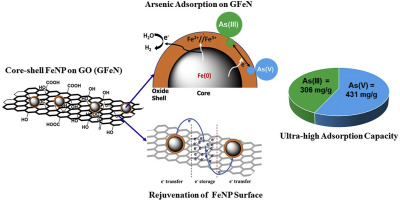当前位置:
X-MOL 学术
›
Chemosphere
›
论文详情
Our official English website, www.x-mol.net, welcomes your feedback! (Note: you will need to create a separate account there.)
Ultra-high arsenic adsorption by graphene oxide iron nanohybrid: Removal mechanisms and potential applications.
Chemosphere ( IF 8.8 ) Pub Date : 2020-04-08 , DOI: 10.1016/j.chemosphere.2020.126702 Tonoy K Das 1 , Tamil S Sakthivel 2 , Aadithya Jeyaranjan 2 , Sudipta Seal 3 , Achintya N Bezbaruah 1
Chemosphere ( IF 8.8 ) Pub Date : 2020-04-08 , DOI: 10.1016/j.chemosphere.2020.126702 Tonoy K Das 1 , Tamil S Sakthivel 2 , Aadithya Jeyaranjan 2 , Sudipta Seal 3 , Achintya N Bezbaruah 1
Affiliation

|
Iron (Fe)-based adsorbents have been promoted for aqueous arsenic adsorption because of their low cost and potential ease of scale-up in production. However, their field application is, so far, limited because of their low Fe use efficiency (i.e., not all available Fe is used), slow adsorption kinetics, and low adsorption capacity. In this study, we synthesized graphene oxide iron nanohybrid (GFeN) by decorating iron/iron oxide (Fe/FexOy) core-shell structured iron nanoparticles (FeNPs) on the surface of graphene oxide (GO) via a sol-gel process. The deposition of FeNPs on GO for the nanohybrid (GFeN) improves Fe use efficiency and arsenic mobility in the nanohybrid, thereby improving the arsenic removal capacity and kinetics. We achieved removal capacities of 306 mg/g for As(III) and 431 mg/g for As(V) using GFeN. Rapid reduction (>99% in <10 min) of As(III) and As(V) (initial concentration, C0 = 100 μg/L) was achieved with the nanohybrid (250 mg/L). There were no significant interferences by the coexisting anions and organic matters at environmentally relevant concentrations. Based on the experimental data, we have proposed that both electrostatic interaction and surface complexation contributed to ultra-high arsenic removal by GFeN. The GO sheets acted as the reservoirs for the electrons released during surface corrosion of the FeNPs and the electrons were transferred back to the FeNPs to rejuvenate the oxidized surface. The rejuvenated FeNP surface layer helped in additional arsenic removal.
中文翻译:

氧化石墨烯纳米铁的超高砷吸附:去除机理及潜在应用。
铁(Fe)基吸附剂由于其低成本和潜在的易于规模化生产而被促进用于含水砷吸附。然而,由于它们的低的Fe使用效率(即,并非所有可用的Fe都被使用),缓慢的吸附动力学和低的吸附容量,迄今为止,它们的现场应用受到限制。在这项研究中,我们通过溶胶-凝胶工艺在氧化石墨烯(GO)的表面上装饰了铁/氧化铁(Fe / FexOy)核-壳结构的铁纳米颗粒(FeNPs),从而合成了氧化石墨烯纳米铁(GFeN)。Fe纳米复合物(GFeN)在GO上的沉积提高了纳米复合物中Fe的利用效率和砷的迁移率,从而提高了除砷能力和动力学。使用GFeN对As(III)的去除容量为306 mg / g,对于As(V)的去除容量为431 mg / g。快速减少(< 用纳米混合液(250 mg / L)获得了10分钟的As(III)和As(V)(初始浓度,C0 = 100μg/ L)。在环境相关浓度下,共存的阴离子和有机物没有明显的干扰。根据实验数据,我们提出静电相互作用和表面络合都有助于GFeN去除超高砷。GO片充当FeNPs腐蚀期间释放的电子的储存库,并且电子被转移回FeNPs以使氧化的表面恢复活力。再生的FeNP表面层有助于进一步去除砷。在环境相关浓度下,共存的阴离子和有机物没有明显的干扰。根据实验数据,我们提出静电相互作用和表面络合都有助于GFeN去除超高砷。GO片充当FeNPs腐蚀期间释放的电子的储存库,并且电子被转移回FeNPs以使氧化的表面恢复活力。再生的FeNP表面层有助于进一步去除砷。在环境相关浓度下,共存的阴离子和有机物没有明显的干扰。根据实验数据,我们提出静电相互作用和表面络合都有助于GFeN去除超高砷。GO片充当FeNPs腐蚀期间释放的电子的储存库,并且电子被转移回FeNPs以使氧化的表面恢复活力。再生的FeNP表面层有助于进一步去除砷。GO片充当FeNPs腐蚀期间释放的电子的储存库,并且电子被转移回FeNPs以使氧化的表面恢复活力。再生的FeNP表面层有助于进一步去除砷。GO片充当FeNPs腐蚀期间释放的电子的储存库,并且电子被转移回FeNPs以使氧化的表面恢复活力。再生的FeNP表面层有助于进一步去除砷。
更新日期:2020-04-08
中文翻译:

氧化石墨烯纳米铁的超高砷吸附:去除机理及潜在应用。
铁(Fe)基吸附剂由于其低成本和潜在的易于规模化生产而被促进用于含水砷吸附。然而,由于它们的低的Fe使用效率(即,并非所有可用的Fe都被使用),缓慢的吸附动力学和低的吸附容量,迄今为止,它们的现场应用受到限制。在这项研究中,我们通过溶胶-凝胶工艺在氧化石墨烯(GO)的表面上装饰了铁/氧化铁(Fe / FexOy)核-壳结构的铁纳米颗粒(FeNPs),从而合成了氧化石墨烯纳米铁(GFeN)。Fe纳米复合物(GFeN)在GO上的沉积提高了纳米复合物中Fe的利用效率和砷的迁移率,从而提高了除砷能力和动力学。使用GFeN对As(III)的去除容量为306 mg / g,对于As(V)的去除容量为431 mg / g。快速减少(< 用纳米混合液(250 mg / L)获得了10分钟的As(III)和As(V)(初始浓度,C0 = 100μg/ L)。在环境相关浓度下,共存的阴离子和有机物没有明显的干扰。根据实验数据,我们提出静电相互作用和表面络合都有助于GFeN去除超高砷。GO片充当FeNPs腐蚀期间释放的电子的储存库,并且电子被转移回FeNPs以使氧化的表面恢复活力。再生的FeNP表面层有助于进一步去除砷。在环境相关浓度下,共存的阴离子和有机物没有明显的干扰。根据实验数据,我们提出静电相互作用和表面络合都有助于GFeN去除超高砷。GO片充当FeNPs腐蚀期间释放的电子的储存库,并且电子被转移回FeNPs以使氧化的表面恢复活力。再生的FeNP表面层有助于进一步去除砷。在环境相关浓度下,共存的阴离子和有机物没有明显的干扰。根据实验数据,我们提出静电相互作用和表面络合都有助于GFeN去除超高砷。GO片充当FeNPs腐蚀期间释放的电子的储存库,并且电子被转移回FeNPs以使氧化的表面恢复活力。再生的FeNP表面层有助于进一步去除砷。GO片充当FeNPs腐蚀期间释放的电子的储存库,并且电子被转移回FeNPs以使氧化的表面恢复活力。再生的FeNP表面层有助于进一步去除砷。GO片充当FeNPs腐蚀期间释放的电子的储存库,并且电子被转移回FeNPs以使氧化的表面恢复活力。再生的FeNP表面层有助于进一步去除砷。



























 京公网安备 11010802027423号
京公网安备 11010802027423号